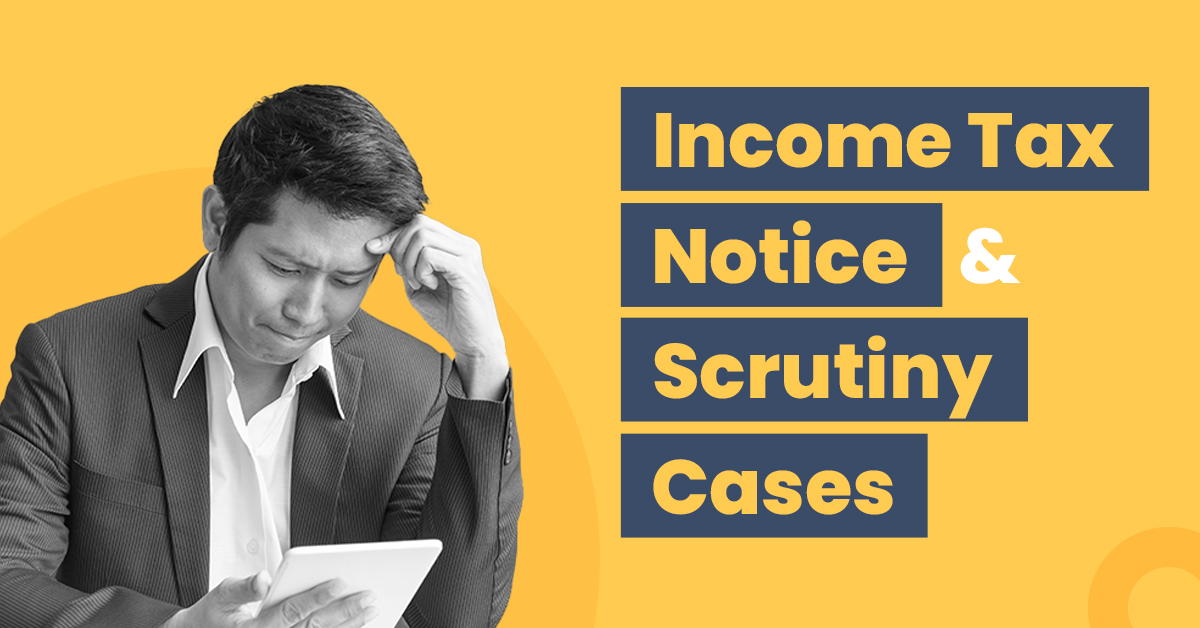Guide to Income Tax Notice & Scrutiny Cases


An income tax notice is a written communication which the Income Tax Department of India sends to the taxpayers stating the issue that has cropped with their tax account. The main intention of sending an income tax notice is to commence with the revenue audit process that has been filed by a taxpayer and ensure that taxpayers have not dodged paying tax or have not underpaid it.
Upon receiving such notice, taxpayers must act immediately on it and resolve issues with the concerned tax authorities of the country.
Also Read: Sukanya samriddhi yojana vs mutual fund
When Do You Receive an Income Tax Notice?
Here are a few reasons when you may receive an income tax notice upon selection of your case for scrutiny assessment.
- Failing to File ITR (Income Tax Returns)
- The first and the most obvious subject of scrutiny by concerned authorities is the inability of an individual to file their tax returns.
- Individuals have to file their taxes if the gross annual income exceeds Rs. 2,50,000 in a fiscal year.
- Again, one should file their income tax reports at regular intervals rather right before the due date, thereby avoiding any laxity or irregularity.
- Taxpayers must file their income tax return even if their employer has deducted TDS from their payment at source.
- There are times a taxpayer can end up filing the wrong ITR form. In addition, they can miss out on mentioning any important information. Such instances also attract notice of the Income Tax Department, and they end up sending a scrutiny notice.
- Cases when you hold a foreign asset or when you hold the position as a signing authority in any foreign bank account, being a resident Indian, it is mandatory for you to file an ITR for avoiding notice.
- Mismatch in TDS Credit
- Taxpayers can receive Income Tax notice if the declaration of the TDS filing and their self-assessment is not in line. Simply put, in case the TDS that taxpayers submit along with their return is not on par with that visible on the Traces website, they will be questioned.
Taxpayers can get an Income Tax notice, when there is a lack of alignment between the two.
- Furthermore, if taxpayers are getting to reap two tax reduction benefits after changing their job in a financial year, they must report the same to concerned authorities.
An employee can avail of one tax benefit from one employer at one time. In case, they are yet to report regarding the two reduction benefits, their income tax filings can be questioned.
- Rapid Rise or Fall in Income
- If there is a sudden increment or decrement in an individual’s income over a year or so, then his or her income tax filing can be subjected to scrutiny.
Though businesses with their volatile nature get the benefit of doubt, salaried individuals with a steady income status also encounter questions pertaining to their sudden rise or drop in income.
- Furthermore, payslips of such salaried personnel can also be examined by the IT department.
- Not Including Other Sources of Income
- It is imperative for individuals to report all the incomes made in a calendar year in the tax return. In case one does not notify their income earned from sources like fixed deposits, recurring deposits or interest earned from a savings account, the Income Tax Department may send a notice raising the issue.
It will be assumed that the individual is not maintaining transparency and is trying to escape paying taxes as per their actual income.
- Also, there are scenarios where bankers deduct TDS at a much lower rate, but employees belong to higher tax slabs. In such a case, individuals can come under the scrutiny of the IT department for not disclosing complete information.
- High-value Transaction
- If the transaction value that an individual has made is higher as per the mentioned status of the individual’s income, it will also lead them to get an issue of notice.
To exemplify, if the salary of a working professional is ₹5 lakh but has total bank deposits exceeding ₹10 lakh, on noting such transaction status the IT department will send across a notice. [Take note of the fact that all transactions made by you are filed by certain institutions like your bank to the IT department via the annual information return.]
- It is important for taxpayers to submit receipts for cash deposits of ₹10 lakh and above. They must also provide bills and payments and for credit card
Also Read: Guide for Income Tax Payment Online
How to Deal With Scrutiny Cases Issues by the Income Tax Department?
The scenarios mentioned above will help individuals make a checklist in advance to avoid getting income tax notices while filing their income tax.
The following steps below can help one deal with the aforementioned scrutiny cases.
- Step 1: Confirmation
Once taxpayers receive a scrutiny notice, they must delve into the matter and know why it has been sent their way. They must refer to the PAN details mentioned in the notice to confirm it is actually for them.
- Step 2: Assessment
Secondly, they must go through the validity of the income tax notice and then go through the names of officials who are in charge of issuing it. It is better to check the individuals’ designation, ward details etc., to avoid getting scammed.
- Step 3: Resolve
In case of an error with the TDS, employees can request their employer, who deducts TDS salary, to deposit the same in the government treasury within the stipulated time. Next, employees must reconcile the original TDS with that of the Tax credit statement. In case of any discrepancy, they must reach the deductor.
- Step 4: Maintain Transparency
Suppose employees have received scrutiny notice for not disclosing their other sources of income. In that case, they must request their banker by the end of the financial year to provide the interest statement reflecting all their deposits made in different accounts.
- Step 5: Report Every Issue
On getting scrutiny notice for unnatural transactions, every transaction must be reported by the individuals. Moreover, in case individuals have faced loss, even that must be reported.
The Income Tax Department is in charge of monitoring all taxpayer transactions. Individuals who have issues with their income tax returns are questioned and one must address the issues and dodge the penalty by solving them appropriately and reporting them on time.
Also Read: Know How to Check Income Tax Refund Status
Types of Income Tax Scrutiny Notice
Under Section 143(2) of the Income Tax Act of 1961, tax scrutiny notice is issued in the following types.
- Limited Scrutiny
In limited scrutiny, Computer-Assisted Scrutiny Selection (CASS) is used to find discrepancies in the income tax returns of an individual. It is done on the basis of predefined factors and is automatically highlighted by the computer.
Limited scrutiny helps the Income Tax department to find out income tax filings that are devoid of supporting documents that taxpayers must have submitted while filing ITR.
- Manual Scrutiny
As the name suggests certain taxes need thorough scrutiny by the CBDT (Central Board of Direct Taxes) as per predefined guidelines.
- Complete Scrutiny
In complete scrutiny, the entire return filed, along with the supporting documents, is scrutinised based on the discrepancies as flagged by the CASS (computer-assisted scrutiny selection). Furthermore, in this type of scrutiny, the concerned assessing officer inspects different aspects of the income tax return filed in a particular financial year.
There are some other categories of income tax notices that are based on the different Sections of our Income Tax Act. The type of notice is based on the cause of issuing it.
- Notice under 139 (9)
Taxpayers receive an Income Tax notice under Section 139(9) of ITA in case of filing a defective income tax. The defect can arise when a wrong ITR is filed, in case of missing information and incomplete return.
Individuals will have to bear a penalty if they choose not to respond to the notice within the stipulated time period of 15 days, as given by the Assessing Officer (AO). Other consequences that can occur are loss of certain exemptions, non-carry-forward of an individual’s losses, interest, etc., as per the Income Tax Act, India.
- Notice under 148
In case the AO finds out that the employees have not maintained transparency regarding their income status. For instance, they have filed for taxation on a lower income than they receive or they have not filed the ITR at all. All these instances will lead an employee towards income escaping assessment.
The time allocated for sending the notice is dependent on the nature and amount of earnings that employees have escaped. In such circumstances, assessing officers initiates proceedings as per Section 147 and sends notice accordingly under Section 148 of the Income Tax Act.
- Notice under (156)
This income tax notice, known as a notice of demand under Section 156, is sent to employees in case they have a penalty, fine, tax or any amount that is payable to the Income Tax Department. An Assessee can see the payable sum in the form and clear it within 30 days of receiving it.
If concerned employees delay the tax payment, they will have to bear a simple interest of 1% every month as per Section 220 (2).
- Intimation under Section 143 (1)
When the Income tax return is processed by the IT department, then intimation is issued by CPC and is sent to all taxpayers. First, the notice reflects the tax liability, which is to be cleared within 30 days of receiving it. Secondly, the notice shows if there is any additional refund or whether the return income tax filing is in coherence with the assessment of the AO.
- Notice under Section 142 (1)
Taxpayers will receive this income tax notice in mainly two cases firstly if the AO (assessing officer) is in need of more information and supporting documents related to income tax returns. Secondly, if the Assessing Officer wants taxpayers to file their return in case, they have not filed it.
The main aim of sending this notice is to retrieve additional details before making an assessment. In case assesses are not complying with this notice, they will be levied a penalty of ₹10000 under Section 271 (1)(b) of ITA. It can also lead to Best Judgement under Section 144.
- Notice under 131
If the Assessing Officer finds out that taxpayers are hiding their income or a part, he or she can send notice to employees under Section 131 of ITA. AO enquires and will like to refer to the Taxpayer’s books of accounts and further scrutinise the income status.
Also Read: TDS On Salary – Calculation, Deductions, Limit & more
Final Word
Income tax is a type of direct tax that individuals must pay responsibly. In case there is any error with respect to filing of tax or TDS, taxpayers receive an income tax notice from the Income Tax Department.
In order to dodge such anomalies, taxpayers must be disciplined and transparent while filing their income tax. However, if they have received such notice, they must take immediate action and resolve the matter with transparency with the concerned tax authorities.
Frequently Asked Questions
What is the best way to reply to a tax scrutiny notice?
Taxpayers must respond to the notice within the mentioned time. They must go through the ins and outs of the notice and act accordingly. They can also opt for the e-proceeding facility to submit their responses on time. Even taking the assistance of a chartered accountant will prove effective while responding to income tax notice.
How to check income tax notices?
Taxpayers can check income tax notices from the dedicated income tax portal. However, not every notice can be tracked from the portal. In such cases, taxpayers must visit ITD and ask their queries.
How to clear outstanding tax payment on demand?
Taxpayers must first go to the IT department’s e-filing official website and access the account. Under the header ‘Respond to Outstanding Tax demand’, taxpayers can track the amount of outstanding tax demand. Then, they must select ‘click here’ under the ‘Pay Tax’ column and get redirected to the official website of NSDL. On this website, they can fill out forms and clear their taxes.







